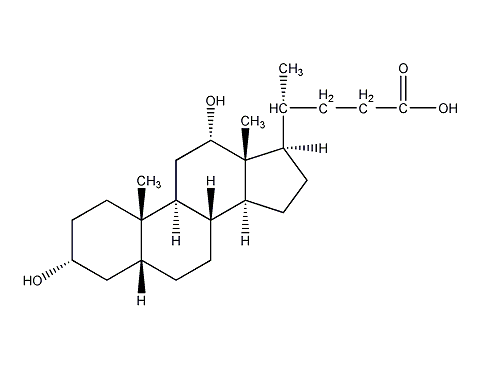
Structural formula
| Business number | 01TX |
|---|---|
| Molecular formula | C24H40O4 |
| Molecular weight | 392.57 |
| label |
deoxycholic acid, deoxycholic acid, 3α,12α-dihydroxy-5β-cholanic acid, N-(3-hydroxypropyl)phthalimide, 3α,12α-Dihydroxy-5β-cholanic acid, 7-Deoxycholic acid, Desoxycholic acid, Lipoids |
Numbering system
CAS number:83-44-3
MDL number:MFCD00003673
EINECS number:201-478-5
RTECS number:FZ2100000
BRN number:3219882
PubChem number:24893692
Physical property data
1. Properties: white crystal.
2. Density (g/mL, 25/4℃): Uncertain
3. Relative vapor density (g/mL, air=1): Uncertain
4. Melting point (ºC): 176~178℃
5. Boiling point (ºC, normal pressure): Uncertain
6. Boiling point (ºC, 5.2kPa) : Uncertain
7. Refractive index: Uncertain
8. Flash point (ºC): Uncertain
9. Specific rotation (º): [α]D20 +55° (C=1, in ethanol).
10. Autoignition point or ignition temperature (ºC): Uncertain
11. Vapor pressure (kPa, 25ºC): Uncertain
12. Saturation Vapor pressure (kPa, 60ºC): Uncertain
13. Heat of combustion (KJ/mol): Uncertain
14. Critical temperature (ºC): Uncertain
15. Critical pressure (KPa): Uncertain
16. Log value of oil-water (octanol/water) partition coefficient: Uncertain
17. Explosion upper limit (% ,V/V): Uncertain
18. Lower explosion limit (%,V/V): Uncertain
19. Solubility: Solubility at 15℃ (g/ L): 0.24 in water, 200.7 in ethanol, 1.16 in ether, 2.94 in chloroform, 10.46 in acetone, and 9.06 in glacial acetic acid. Soluble in alkali hydroxide and alkali carbonate solutions
Toxicological data
1. Acute toxicity:
Rat caliber LD50: 1mg/kg;
Mouse caliber LC50: 1mg/kg
Mouse intravenous LC50 : 130mg/kg
Rabbit intravenous LD50: 2mg/kg
2. Chronic toxicity/carcinogenicity
Mouse skin TCL0: 2700 mg/kg/10W -I; Mouse subcutaneous TCL0: 1120 mg/kg/22W-I
Mouse subcutaneous TC: 1400 mg/kg/22W-I
3. Teratogenicity
p>
Salmonella: 20 mg/L; yeast 2800 umol/L
Ecological data
None
Molecular structure data
1. Molar refractive index: 109.65
2. Molar volume (cm3/mol): 347.8
3. Isotonic specific volume (90.2K ): 905.9
4. Surface tension (dyne/cm): 46.0
5. Polarizability (10-24cm3): 43.46
Compute chemical data
1. Reference value for hydrophobic parameter calculation (XlogP): 4.9
2. Number of hydrogen bond donors: 3
3. Number of hydrogen bond acceptors: 4
4. Number of rotatable chemical bonds: 4
5. Number of tautomers: none
6. Topological molecule polar surface area 77.8
7. Number of heavy atoms: 28
8. Surface charge: 0
9. Complexity: 605
10. Number of isotope atoms: 0
11. Determine the number of atomic stereocenters: 10
12. Uncertain number of atomic stereocenters: 0
13. Determine the number of chemical bond stereocenters: 0
14. Number of uncertain chemical bond stereocenters: 0
15. Number of covalent bond units: 1
Properties and stability
None
Storage method
This product should be sealed and stored in a cool, dry place.
Synthesis method
1. Add sodium hydroxide and 40% aqueous solution to the ox bile hydrolyzate at 80-90°C, stir for 2h span>, cool to 20°C, filter and adjust the filtrate to pH 1.5 with 50% sulfuric acid at 10°C, filter and wash the precipitate with water until neutral. Stir the wet filter cake with a mixed solution of ethyl acetate and benzene (1:1) at 40°C, filter
while hot to remove the insoluble matter, cool it, and the finished product is the crystals that precipitate in the solution.
Purpose
1. Bacteriology and enzymology research.
2.Deoxycholic acid and its salts are surface-active and are safe and effective emulsifiers in cosmetics and pharmaceuticals. They have antifungal and anti-inflammatory effects. , can be used to treat tooth root diseases. It can be used in the treatment of sebaceous gland hypersecretion in dermatology surgery. Used in products such as perfume powder, it can remove excess sebum and sweat stains without making the skin feel dry.

 微信扫一扫打赏
微信扫一扫打赏

